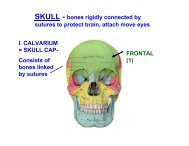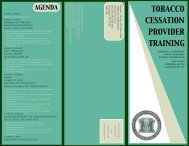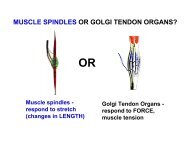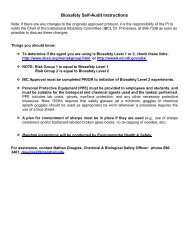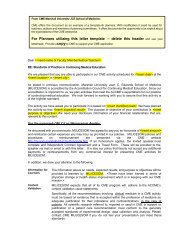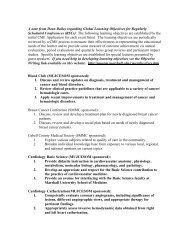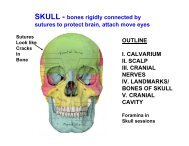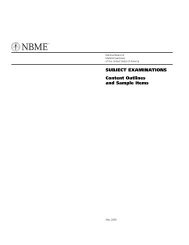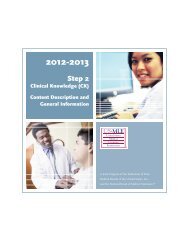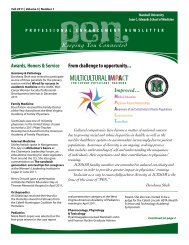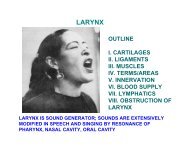FA 5 Progress Report WV-INBRE - Joan C. Edwards School of ...
FA 5 Progress Report WV-INBRE - Joan C. Edwards School of ...
FA 5 Progress Report WV-INBRE - Joan C. Edwards School of ...
- No tags were found...
Create successful ePaper yourself
Turn your PDF publications into a flip-book with our unique Google optimized e-Paper software.
Program Director/Principal Investigator (Last, First, Middle): Rankin, Gary O 61loci confer susceptibility to FCH.The process <strong>of</strong> atherosclerotic plaque formation begins in childhood [21] and the AmericanAssociation <strong>of</strong> Pediatrics now recommends juvenile lipid screening with a positive family history <strong>of</strong>dyslipidemia or premature heart disease [22]. Given the increased levels <strong>of</strong> cholesterol andtriglycerides at an early age, FCH juveniles could be at increased risk for cardiovascular disease.Although several groups have identified and characterized FCH in juveniles [16, 23], there are nostudies on the FCH susceptibility loci in these families.3. Goals and Revised Method <strong>of</strong> Analysis for Genetic Basis <strong>of</strong> Familial Combined HyperlipidemiaThe goal <strong>of</strong> the original FCH proposal was to identify candidate susceptibility genes by performinggenome-wide linkage analysis. We planned to accomplish this goal by pursuing the followingspecific aims:1. Identify novel FCH loci by linkage analysis on a genome-wide set <strong>of</strong> markers.2. Perform genetic fine mapping on the susceptibility loci in order to narrow the region <strong>of</strong> interest.We would then sequence genes in that region in order to identify causal variants.FCH is probably genetically heterogeneous, that is, the FCH phenotype can arise by the action <strong>of</strong>different genes acting individually. Consequently, linkage analysis would require fairly largenumbers <strong>of</strong> families or large individual families in order to identify significant regions. In light <strong>of</strong> thedifficulties in recruiting sufficient numbers <strong>of</strong> FCH families needed for genome-wide linkageanalysis, we propose to adopt an approach based on sequencing the exomes <strong>of</strong> related affectedindividuals. Whole exome sequencing has successfully been used to identify causal variants forabout ten Mendelian disorders (e.g. Miller Syndrome [24, 25, 26]. A number <strong>of</strong> investigators are nowapplying this method to the analysis <strong>of</strong> the families with polygenic and multifactorial disorders [27and G. Jarvik personal communication). By focusing first on the discovery <strong>of</strong> susceptibility variantsin individual families, investigators may circumvent problems associated with data pooled fromgenetically heterogeneous families. FCH is also thought to be an oligogenic disorder, i.e. thedisease may arise from the combined actions <strong>of</strong> several genes. If the cause is in fact oligogenic,there should be sets <strong>of</strong> genes (with variants) that are shared among affected family members.In Y10, we received approval to modify our method <strong>of</strong> identifying FCH susceptibility. We now using astrategy based in part on whole exome sequencing <strong>of</strong> individuals in selected FCH families. Ourimmediate and long-range goals remain unchanged. We will improve our understanding <strong>of</strong> themolecular pathology <strong>of</strong> cholesterol and triglyceride regulation by identifying genes and variants thatpredispose to FCH. The new experimental design will involve several stages: (1) selection <strong>of</strong> FCHfamilies with multiple affected individuals who are known to not have deleterious alleles in the LDLRgene, (2) removal <strong>of</strong> common variants from whole exome sequences by comparison to existingSNP databases such as HapMap and dbSNP and reduction <strong>of</strong> coincident variants by selection <strong>of</strong>variants shared by multiple affected individuals, and (3) confirmation <strong>of</strong> the presence <strong>of</strong> deleteriousalleles in other affected family members and their absence in phenotypically normal individuals.Stage 1. We will begin by selecting families that have at least three affected individuals includingthe proband. Since about 20% <strong>of</strong> FCH affected individuals in one study had significant defects inthe LDLR gene [28, 29], we will perform conventional DNA sequencing on all LDLR exons on twoaffected members in each <strong>of</strong> the “3+ affected” families. We will amplify proximal exons into threelong-range PCR products and sequence the exons using primers and methods described in VanLeuven et al [30].Stage 2. To obtain an initial collection <strong>of</strong> potential FCH variants, we will perform whole exomePHS 2590 (Rev. 06/09)Continuation Format Page



